- Essay Writing
- Dissertation Writing
- Assignment Writing
- Report Writing
- Literature Review
- Proposal Writing
- Poster and Presentation Writing Service
- PhD Writing Service
- Coursework Writing
- Tutoring Service
- Exam Notes Writing Service
Editing and Proofreading Service
Technical and Statistical Services
- Appeals and Re-Submissions
Personal Statement Writing Service
- Sample Dissertations
- Sample Essays
- Free Products

Understanding the Research Onion
The research onion model.
The research onion model was presented by Saunders, Lewis and Thornhill in their book titled Research Methods for Business Students . This model aims to explain the different stages of writing a dissertation to help students create a better organised methodology. The below Research Onion model symbolically illustrates the ways in which different elements involved in the research could be examined to develop the final research design.

Layers of the Research Onion
The research onion consists of six main layers, which can be explained as:
It refers to the set of principles concerning the worldview or stance from which the research is conducted. It is usually studied in terms of ontology and epistemology. Here, ontology refers to the authenticity of the information and how one understands its existence, whereas epistemology refers to the valid information required for the research and how one can obtain it. Philosophical positions used in academic studies are often divided into positivism and interpretivism, where positivism assumes that knowledge is independent of the subject being studied, and interpretivism claims that individual observers have their own perception and understanding of reality. Hence positivist studies are often more scientific and result in testing phenomena, whereas interpretivist studies are often qualitative in nature.
Once the student has chosen the appropriate methodology, the research onion suggests that an appropriate research must be picked. The deductive approach starts with a specific hypothesis development based on the literature review that has been observed by the researcher, and gradually tries to test this hypothesis and check if it holds in particular contexts. In contrast, the inductive approach starts with observations that the researcher uses to create a new theory.
After this, the student is expected to devise the strategy of the study. The research onion suggests that strategies can include action research, experimental research, interviews, surveys, case study research or a systematic literature review. The strategy is chosen based on the data required for the research and the purpose of the study.
Choices of Methods
The research onion suggests mono-method, mixed method and multi-method as possible choices for conducting research. The mono-method comprises only one method for the study. The mixed method is based on the use of two or more methods of research and commonly refers to the use of qualitative and quantitative methodology. Finally, the multi-method uses a wider selection of methods.
Time Horizons
It refers to the time frame of the research. Generally, observations can be of two types based on time horizons, namely cross-sectional and longitudinal. The cross-sectional data is used when all observations are for a single point of time such as in most surveys. Longitudinal data, in contrast, implies the observations for a particular variable that are available for several years, quarters, months or days.
Data Collection and Analysis
This is the final layer of the research onion and consists of the techniques and procedures used. It is used to clearly explain the ways and purposes of the research conducted. At this stage, the student is expected to choose between the primary and secondary data and between qualitative and quantitative data collected from different sources. Data is considered the central piece in the research onion framework.
If you are struggling with choosing the right methods for your dissertation, feel free to use our methodology generator tool that uses elements of the research onion.
Monday - Friday: 9am - 6pm
Saturday: 10am - 6pm
Got Questions?
Email: [email protected]
*We do NOT use AI (ChatGPT or similar), all orders are custom written by real people.
Our Services
Essay Writing Service
Assignment Writing Service
Coursework Writing Service
Report Writing Service
Reflective Report Writing Service
Literature Review Writing Service
Dissertation Proposal Writing Service
Dissertation Writing Service
MBA Writing Service


- Research Essentials
The Research Onion: peeling back the layers
by Glenn Stevens

Embarking on a research journey involves navigating through various layers of complexity, each contributing to the richness and depth of the study. The metaphorical “research onion,” proposed by Saunders et al., provides a systematic framework for comprehending the multifaceted nature of research design. In this post, we’ll peel back the layers of the research onion, exploring its components and elucidating how it guides researchers through the intricacies of the research process.
The Concept of the Research Onion:
The research onion is a metaphorical model that visualizes the layers of a research study, emphasizing the progression from broad philosophical assumptions to specific research methods and techniques. Developed by Mark Saunders, Philip Lewis, and Adrian Thornhill, the research onion encourages researchers to consider each layer systematically, ensuring a cohesive and well-structured study.
Layers of the Research Onion:
- The outermost layer of the research onion encompasses philosophical assumptions, representing the researcher’s worldview and guiding principles. This layer includes ontological (nature of reality), epistemological (nature of knowledge), and methodological (nature of inquiry) considerations.
- Beneath the philosophical assumptions lies the paradigm layer, where researchers choose a specific research approach. Common paradigms include positivism, interpretivism, and pragmatism. The chosen approach shapes the overall research design and influences the methods employed.
- The strategies layer involves selecting the overarching research strategy that aligns with the chosen paradigm. Strategies may include experiments, surveys, case studies, or action research. This layer guides the overall structure of the study and the type of data collected.
- Moving further inward, the time horizon layer addresses the temporal scope of the research. Researchers decide whether their study will be cross-sectional or longitudinal, influencing the duration and timeframe of data collection.
- The data layer involves selecting specific methods for gathering data. Common methods include surveys, interviews, observations, and document analysis. This layer is crucial for collecting relevant and reliable data aligned with the research questions.
- Sampling decisions are made in the sample layer, determining the characteristics and size of the study’s sample. Researchers choose between probability and non-probability sampling methods, aiming for a representative and applicable sample.
- The analysis layer involves selecting appropriate techniques for analyzing the collected data. Quantitative studies may use statistical methods, while qualitative studies may employ thematic analysis or grounded theory. This layer ensures the meaningful interpretation of data.
- At the core of the research onion lies ethical considerations. Researchers must address ethical issues related to participant consent, confidentiality, and the overall integrity of the study. Ethical considerations are integral to conducting responsible and respectful research.

Benefits of the Research Onion Model:
- The research onion provides a systematic approach to decision-making at each layer, ensuring that choices align with the overarching goals of the study.
- By considering each layer of the onion, researchers can create a coherent and well-designed study that aligns with their philosophical assumptions and paradigmatic choices.
- The model allows for flexibility, enabling researchers to adapt their approach based on the nature of the research questions, available resources, and the context of the study.
- The research onion serves as a communication tool, allowing researchers to clearly articulate their philosophical stance, research approach, and methodological choices to peers and stakeholders.
The research onion stands as a guiding metaphor, leading researchers through the layers of complexity inherent in the research process. By systematically considering each layer, researchers can design studies that are methodologically robust, ethically sound, and aligned with their overarching research goals. As you embark on your research journey, let the layers of the research onion guide you, ensuring a thoughtful and comprehensive approach to the exploration of knowledge and discovery.
Recommended reading

Saunders, M., Thornhill, A., & Lewis, P. (2023). Research Methods for Business Students. Pearson. (Click to view on Amazon #Ad)
Research Methods for Business Students has been fully revised for this ninth edition and continues to be the market-leading textbook in its field, guiding hundreds of thousands of student researchers to success in their research methods modules, research proposals, projects and dissertations. From the creators of ‘the Research Onion”.

Posted by Glenn Stevens
Glenn is an academic writing and research specialist with 15 years experience as a writing coach and PhD supervisor. Also a qualified English teacher, he previously had an extensive career in publishing. He is currently the editor of this website. Glenn lives in the UK. Contact Glenn Useful article? Why not buy Glenn a coffee!
Share this:
Tags: academic research research onion
You may also like...

Case Study: Strengths and Weaknesses
by Glenn Stevens · Published


Photographs in Ethnographic Research: the benefits

Reliability in Quantitative Research: a vital quality factor
- Next story Blended Learning: Bridging the Educational Divide
- Previous story Cost of proofreading: How much to proofread my academic writing?

- Academic Writing Service
- Privacy Policy
Useful articles? Why not buy the author a coffee using the link below.
academic research academic writing AI Artificial intelligence ChatGPT data dissertation doctorate Editing ethical considerations ethics feminism finance interviews Introduction language Literature review masters MBA methodology methods motivation Paraphrasing phd phd thesis plagiarism proofreading proof reading psychology qualitative research quantitative quantitative research research research design researcher research ethics sampling student students supervisor survey technology undergraduate university Writing

The research onion for beginners
Today I will explain the research onion in simple terms. This builds on from my last post, where I introduced you to the concept of research philosophy , giving the simple analogy of a tree which demonstrated how philosophy is inherently linked to research design.
What is the research onion?
Layers of the research onion, research philosophy, research approach, research strategy, time horizons, data collection and analysis.
The research onion was developed by Saunders et al in 2007 to describe the stages through which a researcher must pass when developing an effective methodology. Just as I previously explained, in order for your research to have maximum credibility, you must provide explanations and justifications for each level of your methodological decisions. The research onion is basically an extension of the research methods tree.
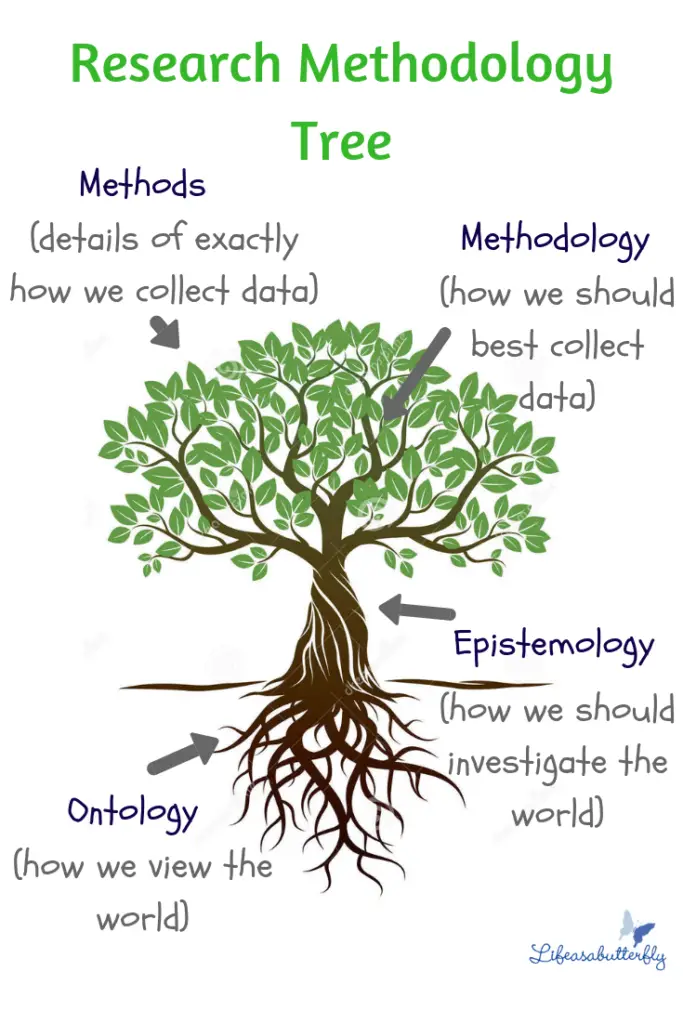
As you can guess, there are different layers to the research onion – the premise being that you start from the outside and peel each layer away until you reach the core. These layers are broken up into six main areas: research philosophy; research approach; research strategy; research choices; time horizons; and techniques and procedures. I will explain what each layer means below.
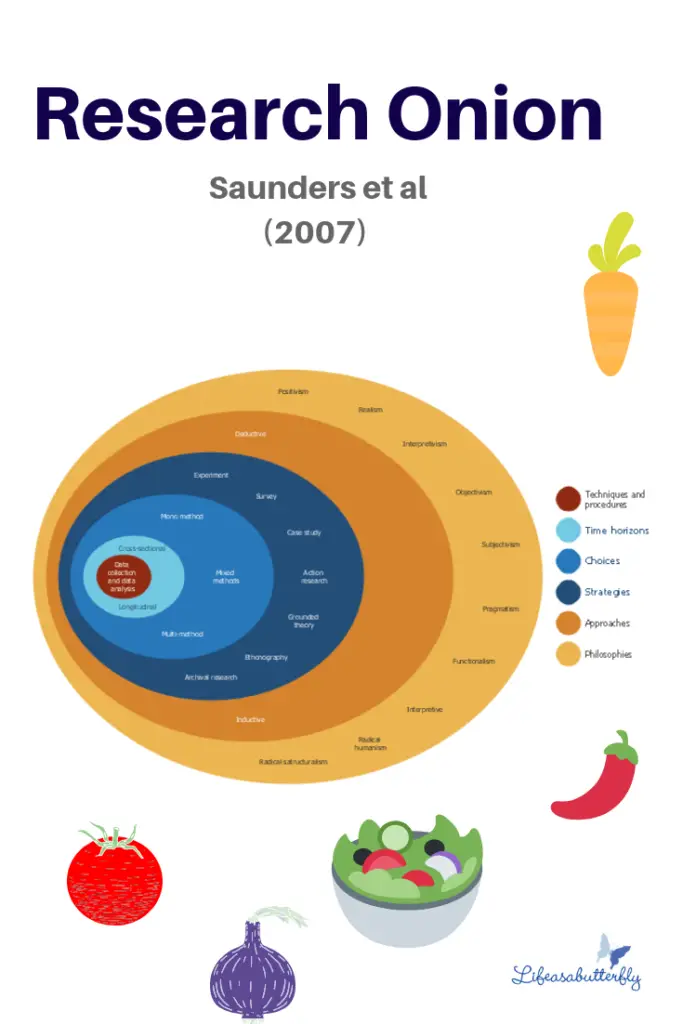
Research philosophy refers to the set of beliefs concerning the nature of the reality being investigated. It is generally examined in terms of ontology and epistemology. I have provided more detail on this in my post- ‘ Ontology and Epistemology: A Simple Explanation ’, but for now I will provide a brief description of each as follows:
- Epistemology: What Constitutes Valid Knowledge and How Can We Obtain It?
- Ontology: What Constitutes Reality and How Can We Understand Existence?
There are two main positions considered here, known as positivism and interpretivism. This underpins the qualitative versus quantitative debate, often referred to as “the scientist versus detective” debate. I explain exactly what all of this means in my post- ‘ Positivism and Interpretivism: A Simple Explanation ’.
This is referring to the approach that the researcher takes, which can largely be described as either inductive or deductive.
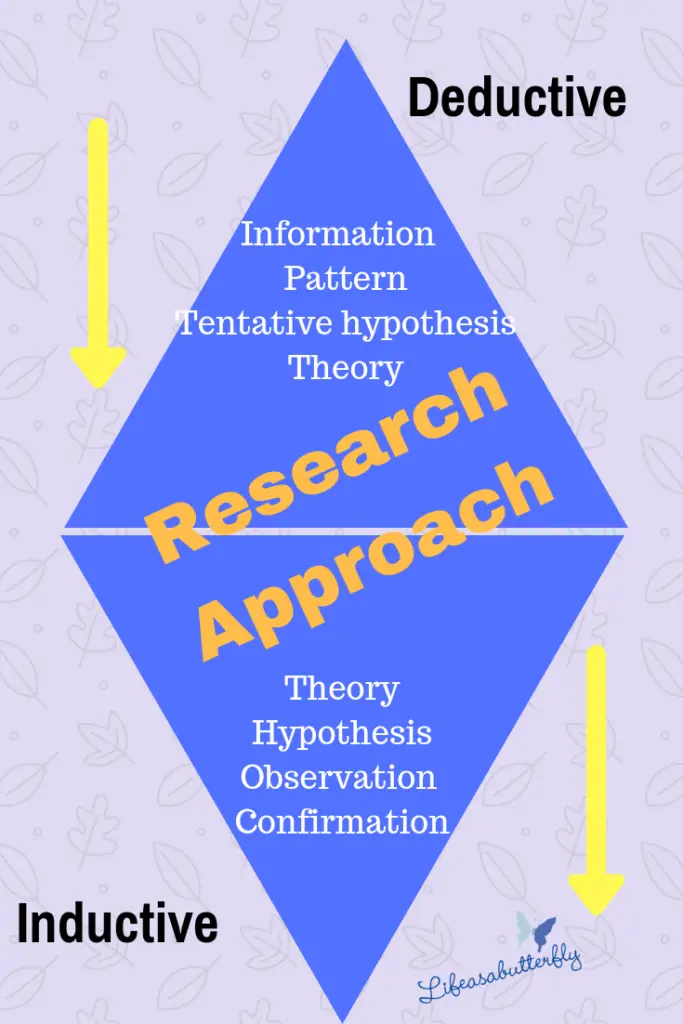
The deductive approach starts small and gets bigger. It starts with a specific hypothesis or hypotheses that have been developed based on information or patterns that have been observed by the researcher. It then seeks to test this hypothesis and develop a broader theory from it.
The inductive approach is the opposite. It starts with a broad theory and then focuses later on the smaller, more specific details. This is sometimes referred to as a move from the specific to the general.
Typically, a deductive approach is associated with quantitative research and an inductive approach is associated with qualitative research.
There are some great texts on this, which will give you a more detailed explanation. One of my favourites is ‘ Key Concepts in the Philosophy of Social Research’ by Malcolm Williams , which I used a lot when writing my PhD thesis.
The strategy layer of the research onion refers to how the researcher intends to carry out the work, i.e. what method of data collection will be used. You can read more about research method strategies in Cresswell’s book ‘ Research Design: Qualitative, Quantitative, and Mixed Methods Approaches ‘ .
The choices outlined in the research onion include the mono method, the mixed method, and the multi-method.
The mono-method involves using one research approach for the study. Next, the mixed-methods required the use of two or more methods of research, and usually refers to the use of both a qualitative and a quantitative methodology. In the multi-method, a wider selection of methods is used. You can also read more about the use of mixed methods research in Cresswell’s text , which is personally one of my favourites- it’s easy to understand and provides detailed explanations.
The Time Horizon refers to the time frame within which the project is intended for completion. According to the research onion, there are two types of time horizons: cross-sectional and longitudinal.
The cross-sectional time horizon is when there is a pre-set time established for the collection of data. A longitudinal time horizon refers to the collection of data repeatedly over an extended period, for example when a person reaches a different age or different seasons throughout the year.
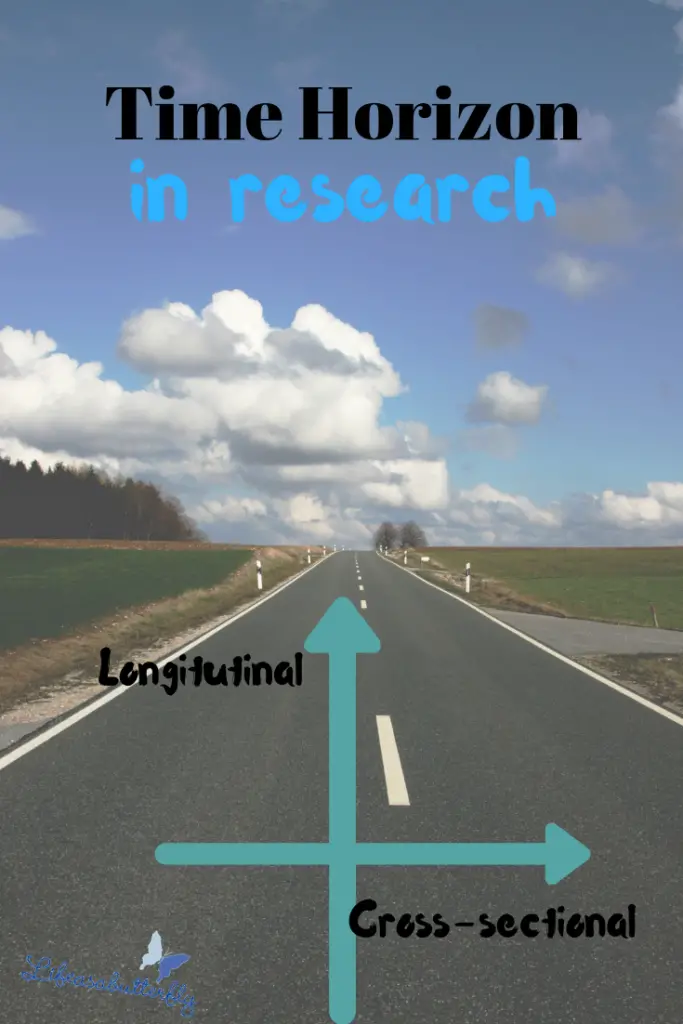
The final layer of the research onion is techniques and procedures. This is the section where you should make explicit exactly how and why you are undertaking the research.
This can be referring to primary data (data collected first-hand for the research project), or secondary data (data that was collected by somebody else and subsequently published).
You will need to make your research design clear, with valid justifications for each stage. This provides a framework that includes the considerations that led to the appropriate methodology being adopted, the way in which the respondents were selected, and how the data will be analysed.
You will also cover research samples in this inner layer of the research onion. A sample is a representative segment of a larger population . In this instance, it is referring to the people who participated in your study. You will need to explain who was selected and why, supported by sampling theory, which you will find in most research methods textbooks. The reader will also want to know about your sample size.
Lastly, it is worthwhile addressing the ethics of your research in this last section of the research onion. This demonstrates that you have been an ethical researcher and that you comply with any regulations set upon you by your university.
So, that sums up the research onion. And in actual fact it sums up your overall methodology chapter for your research project! I have a number of posts covering each of the areas mentioned in the research onion further, so read on should you require further guidance. I also recommend that you use some of the excellent research methods books available to you- I recommend Social Research Methods by Bryman and Research Methodology: A Step by Step Guide for Beginners by Kumar .
Lastly, I have also included a handy YouTube video below that explains the research onion very clearly (I’ll get round to making my own one day).
If you wish to cite any of the content in the post please reference ‘Stainton, Hayley. (2018) Lifeasabutterfly.’

POPPY Approach in Action: How the Diriya Aruna Project Elevates Sri Lanka’s Tea Sector

Training And Capacity Building of Women in Livestock Farming

Nextgen Extension: Transforming Roles and Sparking Innovations

How to End Hunger and Empower Lives: The Heifer’s Way
Blog 132-research onion: a systematic approach to designing research methodology.

- Google Plus
Developing a good research design is important while undertaking quality social science research, and in this blog Dr Mahesh BT illustrates the different stages in designing a research methodology using the Research Onion framework.
When I joined for my PhD, as many of you, I too was curious about research. Along with the curiosity came seriousness, but only after one of my mentors said: “Your thesis is your brainchild and indeed a reflection of you”. I am here now to share a few of the specifics that I learnt during my PhD journey. I will be discussing how to design and present a robust research methodology. Why do I find this concept very crucial? It is because these answers to research questions are valid and reliable – if they are answered through a systematic method(s). Often we find dissertations with a poorly explained research methodology chapter, which is required to be crystal clear in every step, so I was in search of something that can explain things clearly. During my desk research, I came across various ways and means to design research methodology; one of the most crucial revelations for me was a research vegetable called ‘Research onion’. Let us first see what this research onion is all about.
WHAT IS ‘RESEARCH ONION’?
Saunders et al. (2012) proposed the research onion framework (Figure 1), which explains pictorially the various aspects of the research to be examined and planned in order to come up with a sound research design. In other words, the research onion guides the researcher through all the steps that need to be taken when developing a research methodology.
Saunders et al. (2019), divided the research onion into three levels of decisions: 1. First two outer rings, i.e., Research philosophy and Research approach; 2. Research design which constitutes (a) methodological choices, (b) research strategy and (c) time horizon; and (3) tactics, i.e., the inner core of the research onion, which includes data collection and analysis aspects.
Before we strip the research onion let us do an activity. Take an onion and try to peel it from the inside without using a knife. You tried but could not peel it, the systematic way is to peel it from the outside to inside, and this is what we have to do with the research onion as well.
To develop a sound research methodology scholarly research starts with the research question(s), the objectives followed by the series of decisions on choice of research philosophy, approach to research, then the research design, i.e., methodological choices, research strategy, the time horizon, and the last inner core – data collection and data analysis. All the layers of research onion are interrelated and interdependent. In other words, the choice of philosophy influences the approach, which in turn influences the selection of methodological choice, strategy, time horizon, data collection and analysis.
PEELING OUT THE RESEARCH ONION
1.RESEARCH PHILOSOPHY Knowingly or unknowingly a researcher will be making numerous assumptions while embarking on research (Burrell and Morgan 2016).
These assumptions are of three types:
- Ontological assumptions – Assumptions regarding the reality faced in the research or what makes something a reality, and how a researcher can understand existence.
- Epistemological assumptions – Assumptions associated with human knowledge or what forms valid knowledge, whether it can be known, and how a researcher can get it and transfer it.
- Axiological assumptions -These are assumptions about the level of influence of the researcher’s values on the research process or what is essential and valuable in the research.
Further, these assumptions help a researcher to design the research questions, choose appropriate methods, and influence the interpretation of findings (Crotty 1998). These assumptions altogether form the research philosophy of the study. According to Saunders et al. (2012), the term research philosophy refers to ‘a system of beliefs and assumptions about the development of knowledge’.
The ontological assumption is the assumption made by a researcher regarding the nature of reality. Here reality means the study area or a subject domain, such as agricultural extension. The extension fraternity has various assumptions regarding the subject of extension, we assume it to be a study of human (farmers) behaviour, and others say it is the transfer of technology, and so on and so forth. These ontological assumptions may also be with regard to a specific research area in the subject domain. For instance, we study farmers’ adoption of agro-technology, in most adoption studies the researchers presumed that a lower level of adoption (a reality) of technology is the reason for lower crop production. Therefore, the focus was on studying the level of adoption by farmers and how to increase it. On the other hand, some researchers assume technology adoption as a mental process and see that there is low level of adoption everywhere, and so they try to understand why there is a low level of adoption and what are the factors determining the adoption. From this, it is clear that your assumption about the nature of reality (ontology) decides how you view the subject domain (Agricultural Extension) or the research area, which in turn influences what you want to research (what research questions to ask or what research objectives to study).
The epistemological assumption is an assumption made by a researcher regarding knowledge. What forms valid and reliable knowledge? How do we acquire and communicate it? We know that the subject matter of agricultural extension is derived from different disciplines. Therefore, the nature of knowledge will be diverse; it may constitute numerical data (e.g., number of women FPOs) to textual data (results of in-depth interview or focused group discussion), or even visual data (social map, resource map, sociogram). In extension research, facts, opinions, narratives and stories constitute valid knowledge, provided it follows a systematic process of enquiry. You will come across various research studies in extension where the researcher has used different epistemology in their research, research purely based on case studies, and some dealing only with factual stuff.
The axiological assumption is an assumption made by a researcher regarding the influence of values and beliefs on the research. The researcher tries to be free from values and beliefs intruding into the research or positively considers and acknowledges values and beliefs influencing the research process and the conclusions. Sometimes we need to decide on whether the values and beliefs of the research respondents should be considered or not. Researchers argue, as reported by Saunders et al. (2019), that it is very tough to keep ourselves free from the influence of values and beliefs. For instance, as a researcher you might have come across your advisor saying “parametric test is stronger than non-parametric”, “qualitative data gives in-depth understanding about a phenomenon than quantitative data”. What are these assumptions? They are the aspects of research your advisor values more.
At this juncture, you might have questioned yourself – why should I be making assumptions and know the different research philosophies when I can directly collect data, analyse and report the results? There are several aspects for which these assumptions are essential they are listed below.
- Assumptions are your research tour guide; they tell you how to conduct the research, what should be your role – whether you should maintain objectivity or can subjectivity be expressed. They tell you what methods you can follow.
- The researcher has to defend his/her work at various levels. As a student researcher, we get suggestions from the advisory committee or institutional review board to strictly go for quantitative methods with probability sampling, and try to avoid qualitative methods. This is due to the difference in the assumptions or more specifically, the research philosophy they follow. The most challenging is to convince the journal reviewers and editors, there are chances of your paper getting rejected because your philosophy is different from what they follow. Therefore, to show that your overall approach to research is justifiable, you should state your assumptions (research philosophy) very clearly.
- Another issue we come across is sweeping apologies in our dissertation, for instance, a researcher apologises for not interviewing a large number of respondents in qualitative research; and the other one is failing to get an in-depth understanding due to the quantitative nature of research. No! You need not apologise, all that you need to do is follow the standard methods and procedure that suits your research philosophy. Therefore it is very important to understand the various research philosophies.
According to Saunders et al. (2019), there are five research philosophies: (1) positivism; (2) critical realism; (3) interpretivism; (4) postmodernism; and (5) pragmatism. The detailed explanation of these five research philosophies is presented in Tables 1 to 5.
2. THE RESEARCH APPROACH OR APPROACH TO THEORY DEVELOPMENT
The second ring in the research onion contains the research approach. If we critically think on what a researcher does in research, we can classify them into three aspects – theory testing, theory building, and theory modification. The point I am trying to make here is that the research we undertake involves the use of theory which we may or may not name in our research design. You will find the essence of theory in the conclusions of research findings. The selection of a particular philosophy that was discussed in the first section will determine the approach you choose for the development of the theory or for the reasoning behind your findings. Further, the approach you select will influence the choice of research design and methods (Babbie 2010).
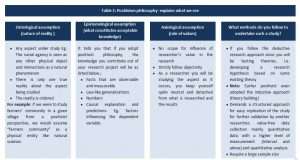
Source: Developed from Saunders et al. (2019) Note: Application of positivist philosophy in social science research is a matter of scholarly debate. However, a researcher can apply some of the assumptions and methods with caution and rationality. Suggested reading: Thomas Houghton, Does positivism really ‘work’ in the social sciences? Link: https://www.e-ir.info/2011/09/26/does-positivism-really-%E2%80%98work%E2%80%99-in-the-social-sciences/
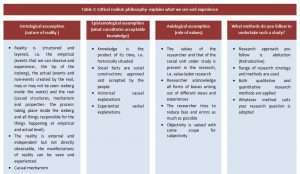
Source: Developed from Saunders et al. (2019) Suggested reading : Fletcher Amber J. Applying critical realism in qualitative research: Methodology meets method. Link: https://www.tandfonline.com/doi/abs/10.1080/13645579.2016.1144401?journalCode=tsrm20
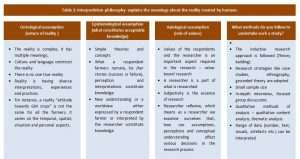
Source: Developed from Saunders et al. (2019) Suggested reading : Chen Y Y, Shek D T L and Bu F F. 2011. Applications of interpretive and constructionist research methods in adolescent research: Philosophy, principles and examples. International Journal of Adolescent Medicine and Health 23(2).doi:10.1515/ijamh.2011.022 https://pubmed.ncbi.nlm.nih.gov/21870675/
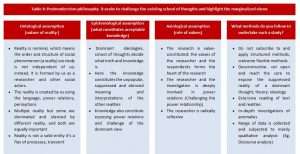
Source: Developed from Saunders et al. (2019) Suggested reading : Rosenau P V. Postmodernism: Methodology. https://doi.org/10.1016/B0-08-043076-7/00692-6 Link : https://www.sciencedirect.com/science/article/pii/B0080430767006926
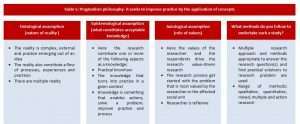
Source: Developed from Saunders et al. (2019) Suggested reading: Crist J D, Parsons M L, Warner-Robbins C, Mullins M V and Espinosa Y M. 2009. Pragmatic action research with 2 vulnerable populations. Family & Community Health 32(4):320–329. doi:10.1097/fch.0b013e3181b9
According to Saunders et al. (2012), there are three research approaches viz., induction, deduction, and abduction. A brief overview of the research approaches is presented in Table 6.
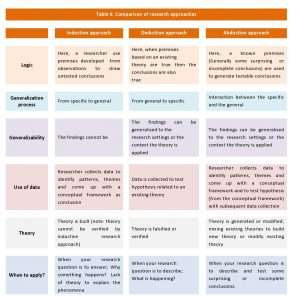
2.1 In this section I have graphically explained all the three research approaches using flowchart with hypothetical examples. 2.1.1 Inductive approach to research
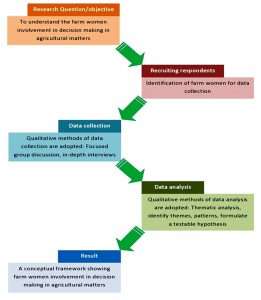
Suggested reading: Ferguson K M, Kim M A and McCoy S. 2011. Enhancing empowerment and leadership among homeless youth in agency and community settings: A grounded theory approach. Child and Adolescent Social Work Journal 28(1):122. https://doi.org/10.1007/s10560-010-0217-6
2.1.2 Deductive approach to research
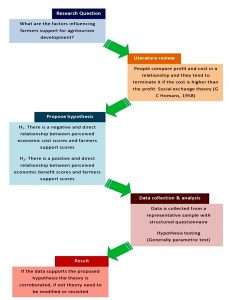
Suggested reading: Chia-Pin Yu, Shu Tian Cole and Chancellor Charles. 2018. Resident support for tourism development in rural midwestern (USA) communities: Perceived tourism impacts and community quality of life perspective. Sustainability, MDPI, Open Access Journal 10(3):1-17.
2.1.3 Abductive approach to research
You may find some surprising or incomplete observations or conclusions regarding any social aspect; you wanted to study it both empirically as well as know the subjective opinions of people for better understanding. In this situation, you follow the abduction approach in which your research will combine the elements of both the inductive and deductive approaches. To put it in simple words, in abduction ‘You build a theory and then go for its empirical testing’.
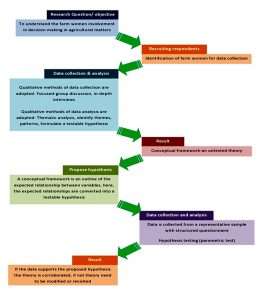
Suggested reading: Bristow A, Robinso S K and Ratle O. 2017. Being an early-career CMS academic in the context of insecurity and ‘Excellence’: The dialectics of resistance and compliance. Organization Studies 38(9):1185–1207.
Research design: It is the overall plan of a research project which involves three distinct but interrelated aspects. They are: methodological choice, research strategy and time horizon. Let us understand them separately. Sanders et al. (2019) classified research designs into three types: (1) quantitative research design; (2) qualitative research design; and (3) mixed methods research design. I have attempted to develop a schematic explanation for qualitative and quantitative research design (Figures 4 and 5, respectively) for better understanding.
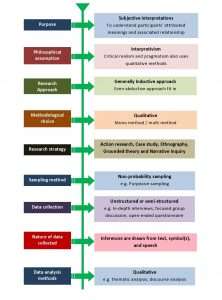
3. METHODOLOGICAL CHOICE
Methodological Choice involves the selection and use of a quantitative, qualitative, or mixed methods research design. In the mono method, a single data collection technique is utilized, followed by corresponding qualitative or quantitative analysis procedures. In the multiple method design, more than one data collection techniques and analysis procedures are employed (Collis and Hussey 2013). Alternatively, a mixed-method approach utilizes both qualitative and quantitative data collection techniques and analysis procedures (Creswell 2013).
According to Saunders et al. (2019), mixed method research can be classified into three ways which are as follows:
- Concurrent mixed methods research: Here a researcher collects both qualitative and quantitative data and analyses them in a single phase study.
- Sequential mixed methods research : Here a researcher collects and analyses data in two phases, which can further be divided into two forms:
- sequential exploratory research design: where a researcher collects and analyses qualitative data in the first phase, followed by quantitative data collection and analysis in the second phase;
- sequential explanatory research design: Here a researcher collects and analyses quantitative data in the first phase followed by qualitative data collection and analysis in the second phase.
- Sequential multi-phase: In this a researcher collects and analyses data in more than two phases, in sequence. For example, qualitative followed by quantitative and then qualitative.
4. THE RESEARCH STRATEGY
The research strategy describes how the researcher aims to carry out the work (Saunders et al . 2007). There are several research strategies, viz., Experimental design, Survey design, Archival research, Case study, Ethnography, Action research, Grounded theory and Narrative inquiry (Saunders et al. 2012). Here we can include other research strategies appropriate to our study.
- Experimental design : Here, a researcher tries to study a cause-effect relationship between two or more variables. He/she decides to systematically manipulate the independent variable to study the corresponding changes in the dependent variable.
- Survey design: Here, a researcher tries to seek answers for ‘what’, ‘who’, ‘where’, ‘how much’ and ‘how many’ types of research questions. Data is collected and analyzed from a sample of individuals.
- Case study: is an empirical inquiry of an individual social unit. Here the researcher tries to seek answers for ‘how’ and ‘why’ questions.
- Action research : A systematic inquiry to address real-life practical problems. Here a researcher tries to find practical solutions for problems through participation and collaboration with members of a social unit.
- Grounded theory: This is a systematic inductive method for conducting qualitative research to develop a theory.
- Ethnography : is a research strategy adopted to explore cultures and societies. Here a researcher collects data through direct interaction and involvement so as to gain firsthand information from research subjects.
- Archival research: A systematic inquiry wherein primary sources held in archives are studied for evidence collection or deep understanding. Here a researcher does not use secondary sources relevant to the research topic.
5. TIME HORIZON
Research can be grouped into two types based on time, i.e., longitudinal or successive independent samples; and cross-sectional (Bryman and Bell 2015). The longitudinal study refers to the study of a phenomenon or a population over a period of time (Caruana et al. 2015). A cross-sectional study is a ‘snap-shot’ study, it means a phenomenon or a cross-section of the population is studied for one time (Setia 2016). Please read the suggested reading given below to understand one of the longest researches in the history of social science research.
Suggested reading: Hastorf A H 1997. Lewis Terman’s longitudinal study of the intellectually gifted: Early research, recent investigations and the future. Gifted and Talented International 12(1):3–7. doi:10.1080/15332276.1997.11672858
6. DATA COLLECTION AND ANALYSIS
The inner circle of research onion is made up of ‘tactics’ which refers to aspects about the finer details of data collection and analysis. In this section, the following aspects are described.
A. Data collection tools and procedures : Data collection tools such as scale, questionnaire, mail survey, etc., and procedures such as scale construction, interviews, focused group discussion, etc. B. Study Area – A brief description about the study area and why you have selected this locale, supported by reliable data. C. Research population and sampling procedures : Describe the following aspects in this section:
a. Inclusion /exclusion criteria; b. Sample size; c. Sampling method; d. Sampling plan – Flow chart with a table indicating sample details; e. Sourcing samples : Here the researcher has to describe the source of the study samples; it has the following three aspects:
- Source population(N) : This is the group about which the researcher is going to draw inferences and to which the inclusion and exclusion criteria are applied (Example: women farmers of a district – say may be N=1000);
- Study population (Np): The group which fits the inclusion and exclusion criteria (Example: women farmer growing sunflower, with landholding more than 2 ha and five years of experience, say maybe Np=500);
- Sample (n) : The group selected after following a suitable sampling method, and finally with whom you conduct your study (a representative sample of women sunflower growers sampled from the study population, say maybe n=120).
f. Sample limitations
D. Study Phases: describe in how many phases your study will be done (during planning-synopsis) / was done (while reporting in the thesis) if it was done in multiple phases. Explain the list of the tasks using a Gantt chart (Figure 6).
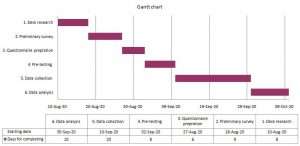
Variables and their measurement: Describe how the concepts, constructs and the variables were identified; this aspect is linked with the theoretical orientation. Provide the operational definition; it means how the variable is measured, mention the level of measurement also. A schematic table would suffice (for example, see Table 7).
Table 7. List of variables their method of measurement and operational definition
F. Statistical analysis: Mention all the statistics tools applied and software(s) used to analyse the research data (in thesis).
G. Ethical considerations: All the ethical aspects considered in the study need to be clearly planned and mentioned. Mention about respondent consent, how sensitive information (in synopsis) was elicited, if any. Report the approval of Research ethics committees, if applicable.
The difference between a researcher and a non-researcher is, whatever a researcher does she/he does it systematically, justifies logically, subjects it to verification, is always open to criticism, ready for self-correction and explicitly expresses what was done, how it was done, why it was done and what was found. A researcher starts with a research problem, raises questions, and transforms it into workable objectives. To find answers to the research questions, we need a sound research methodology. Research onion is one such framework that helps in designing a robust research methodology; simply put, it will help you to make a series of decisions that allows systematic research. We began with three assumptions, viz., ontological, epistemological and axiological, which constitute our research philosophy. Once we decide on the specific philosophy, an appropriate research approach can be adopted based on the research question and philosophy. The deductive approach is adopted for theory testing, inductive approach for theory building, and abductive approach for theory modification.
Further, these two crucial decisions will guide the next important aspect that is research design, which is made up of three important decisions: 1. Methodological choice – whether to follow a qualitative method, quantitative method or a mixed method; 2. Research strategy; and 3. Time horizon – cross-sectional or longitudinal research. Furthermore, the last decision is about very minute intricacies of research that is data collection, analysis and ethical statement.
Authors’ observation
It is often observed in academic discussions that various aspects of research are presented and (or) perceived to be competitive (quantitative versus qualitative, parametric versus non-parametric, probability sampling versus non-probability sampling, small sample size versus large sample size, experimental design versus non-experimental, cross-sectional versus longitudinal, and so on) rather than complimentary. Every aspect of research has got its own importance and relevance. A research scholar values every logical approach to research, and it is possible only after looking at it through all dimensions via the lenses of different questions (why, what, when, where, who, what).
Acknowledgement
I wish to acknowledge and thank the AESA, CRISP, ICAR-CTCRI, MANAGE, NAARM collaborative National Workshop on ‘Advances in Social and Behavioural Science Research’ held from 12 to 17 November 2018 at ICAR-CTCRI, Kerala. This event was an eye opener for me which oriented me towards social science research methodology, and indirectly helped me in my PhD research.
Babbie E. 2010. The practice of social research. 12th Edition. Belmont, USA: Wadsworth.
Bristow A, Robinson S K and Ratle O. 2017.Being an early career CMS academic in the context of insecurity and ‘Excellence’: The dialectics of resistance and compliance’. Organization Studies 38(9):1185–1207.
Bryman A and Bell E. 2015. Business research methods Oxford: Oxford University Press.
Burrell G and Morgan G. 2016. Sociological paradigms and organisational analysis. Abingdon: Routledge (originally published by Heinemann 1979).
Caruana E J, Marius Roman, Jules Hernández-Sánchez and Piergiorgio Soll. 2015. Longitudinal studies. Journal of Thoracic Disease 7(11):537–540. doi: 10.3978/j.issn.2072-1439.2015.10.63. Retrieved from https://www.ncbi.nlm.nih.gov/pmc/articles/PMC4669300/
Chen Y Y, Shek D T L and Bu F F. 2011. Applications of interpretive and constructionist research methods in adolescent research: Philosophy, principles and examples. International Journal of Adolescent Medicine and Health 23(2). doi:10.1515/ijamh.2011.022 https://pubmed.ncbi.nlm.nih.gov/21870675/
Chia-Pin Yu, Shu Tian Cole and Charles Chancellor.2018. Resident support for tourism development in rural midwestern (USA) communities: Perceived tourism impacts and community quality of life perspective. Sustainability, MDPI, Open Access Journal 10(3):1-17.
Crist J D, Parsons M L, Warner-Robbins C, Mullins M V and Espinosa Y M. 2009. Pragmatic action research with 2 vulnerable populations. Family & Community Health 32(4):320–329. doi:10.1097/fch.0b013e3181b91f
Crotty M. 1998. The foundations of social research: Meaning and perspective in the research process. London: Sage.
Collis J and Hussey R. 2013. Business research: A practical guide for undergraduate and postgraduate students. Macmillan International Higher Education.
Creswell J W. 2013. Qualitative inquiry & research design; choosing among five approaches. Third edition. Thousand Oaks, CA: Sage.
Ferguson K M, Kim M A and McCoy S. 2011. Enhancing empowerment and leadership among homeless youth in agency and community settings: A grounded theory approach. Child and Adolescent Social Work Journal 28(1):1-22. https://doi.org/10.1007/s10560-010-0217-6
Hastorf A H. 1997. Lewis Terman’s longitudinal study of the intellectually gifted: Early research, recent investigations and the future. Gifted and Talented International 12(1):3–7. doi:10.1080/15332276.1997.11672858
Saunders M, Lewis P and Thornhill A. 2007. Research methods for business students. (6th ed.) London: Pearson.
Saunders M, Lewis P and Thornhill A. 2019. Research methods for business students. Eighth edition. London: Pearson.
Setia M S. 2016. Methodology series module 3: Cross-sectional studies. Indian Journal of Dermatology 61:261-4. Retrieved from http://www.e-ijd.org/text.asp?2016/61/3/261/182410
Thomas Houghton. 2011.Does positivism really ‘work’ in the social sciences? Link: https://www.e-ir.info/2011/09/26/does-positivism-really %E2%80%98work%E2%80%99-in-the-social-sciences/

You may also like

Blog 226-Humanizing Agricultural Extension or Rendering it Technical?

Blog 225-Know Why Custodian Farmers are Important in Agrobiodiversity Conservation

Blog 224-How Treated Water Can Fuel a Circular Economy in Agriculture
Cancel reply.
Very interesting blog. Enjoyed reading it. I do have a small difference of with respect to one of the statements. Author says ‘you need not be apologetic in saying that sample was small or methods limit interpretation’. I am a firm believer of transparent communication and I feel that it is the role of a researcher to know the limits of the study and also communicate it to the readers, and there is nothing to be apologetic about it (Bsically I disagree with the term too). Infact I see many paper where they make very strong causal statements, when the methods are not really designed for it which I see as a more serious concern. This is my humble opinion, as academician I really enjoyed the blog. I appreciate the efforts of the author in elaborating on a very Important topic.
Thank you Aditya, thank you for your observations and. The very purpose of this blog was to make things systematic and clear. Yes the author strongly believe in reporting every aspect of the research including limitations provided they are indeed limiting the research design. Here the author is trying to state that when the research design demands or permits certain conditions those conditions should not be expressed as limitations, and it doesn’t imply any aspect should be hidden. I welcome your disagreements in the usage of words, we can disagree to agree. I strongly agree with you that even I enjoyed working on this blog. Thank you once again.
Well written.
Very comprehensively covering different paradigms in research methodology, with interesting analogy, Dr Mahesh could peel out research onion, explaining each layer starting from research philosophy to the data collection. Congratulations to Dr Mahesh. Further one important inner layer could be added to the onion, which would make it complete-the layer of research reporting/research communication. Unless we plan how we are going to communicate our research to the others, and communicate effectively through research paper, conference etc., research remains incomplete.
Very Good effort to write the blog to make research methodology easy to understand, Dear Mahesh , I enjoyed reading it

IMAGES
VIDEO